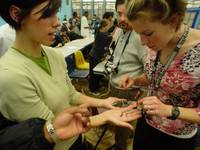The latest intel from around the triple W and from around your back yard. A collaborative news service where we actually admit that we filter and hand pick what we want you to read, from the concerned folks at Buckeye Sustainability Institute
NOTE: This News section may contain portions of copyrighted material. In accordance with Title 17 U.S.C. Section 107, such attributed material is available without profit to people expressing an interest in this information for research.
7.28.2005
New Tests Show Many Perfumes Don’t Pass the Toxicological Sniff Test
A new report from Greenpeace has found that many of the world’s best-selling perfumes contain hazardous levels of certain dangerous chemicals. The organization had the Dutch chemistry lab TNO Environment and Geosciences analyze 36 randomly selected perfumes for the presence of two known toxic hazards: phthalates and synthetic musks, and discovered that both types of chemical were present in the vast majority of samples.
Thirty-four of the tested perfumes were found to contain diethyl phthalate (DEP). The highest levels were found in Calvin Klein’s Eternity for Women, which contained DEP levels of 2.2% by weight. Other heavy hitters included Melvita’s Iris Blue (1.1% by weight) and Jean-Paul Gaultier’s Le Male
(just under 1% by weight).
Synthetic musks were found in 21 of the tested samples. The highest total quantities of these synthetic musks were found in the Body Shop’s White Musk (9.4% of total volume by weight), Gaultier’s Le Male (6.4% by weight), and Cartier’s Le Baiser Du Dragon (4.5% by weight).
Both phthalates and synthetic musks are hazardous to human health. Phthalates are solvents added to perfume formulas because they have an ability to easily evaporate at room temperature. This makes them ideal carriers for perfume fragrances. With phthalates added to its formula, a perfume becomes more "smellable" as evaporating phthalate molecules carry the scent with them into the air. Unfortunately, this ability to enter the air means that phthalates can also easily enter the lungs and the body, where they cause all kinds of havoc. Emerging evidence has linked exposure to phthalates to reproductive and developmental disorders, cancer, organ damage, childhood asthma, and allergies.
**click title for full text**
7.21.2005
EU chemicals law REACH inspires US bill
Background:
Since its introduction in October 2003, the EU's REACH proposal has been the stage for an unprecedented lobbying battle pitting environmental campaigners against industry.
The US administration has so far been critical of REACH, as was revealed in a 2004 US senate report detailing the tactics used by the Bush administration and the US chemical industry to amend the draft EU law. The report mentions a cable sent by then Secretary of State Colin Powell directing US diplomatic posts to "raise the EU chemicals policy" as "a costly, burdensome, and complex regulatory system".
Issues:
US Senator Frank R. Lautenberg introduced draft legislation aiming at better protecting children, mothers and workers against potentially hazardous chemicals.
Introduced on 13 July, the 'Child, Worker and Consumer Safe Chemicals Act' is largely inspired by the hotly debated EU proposal for the registration, evaluation, and authorisation of chemicals (REACH) now at final stage of adoption before the European Parliament.
The draft US bill would force chemical manufacturers to provide health and safety information on chemicals used in consumer products like baby bottles and food wrapping instead of presuming a substance is safe until proven dangerous.
The principle, know as the reversal of the burden of proof, is the cornerstone of REACH.
Senator Lautenberg's proposal follows the publication in June of a US federal report detailing the failures of the 1976 Toxic Substances Control Act (TSCA) in protecting Americans from hazardous chemicals.
The report, by the United States Government Accountability Office (GAO), recommended that the US congress consider providing the US Environmental Protection Agency (EPA) with additional authority to assess chemical risks.
According to Lautenberg, procedures under the TSCA are so daunting that, in 29 years, only five toxic substances have been regulated by the EPA. Currently, the EPA has to demonstrate a chemical poses an "unreasonable risk" to restrict or ban it.
Positions:
"Most Americans believe their government is making sure that chemicals used in the market place are safe. Unfortunately, that simply isn't true," said Senator Lautenberg. "Study after study has shown we have dozens, if not hundreds, of synthetic chemicals in our bodies, yet we have very little information about how they impact our health."
The bill is sponsored by Democrat political heavyweights including 2004 Presidential candidate John Kerry and Hillary Clinton.
In a separate development, the Environmental Working Group (EWG) on 14 July published analyses of the blood from the umbilical cord of ten newborn babies. Performed by an independent laboratory, the tests revealed the presence of 287 industrial chemicals in the blood samples tested, leading the EWG to conclude that "industrial pollution begins in the womb". However, the correct interpretation of blood tests - a practice know as biomonitoring - and their use in policy-making is still subject to controversy (see related LinksDossier).
7.12.2005
Green energy will never meet needs, says Exxon
ExxonMobil has dismissed solar and wind energy as "inconsequential" and urges politicians to concentrate on sources that would continue to provide 99% of future energy needs.
Lee Raymond, the chairman and chief executive, also argues that areas such as the Arctic National Wildlife Refuge in Alaska should be opened to exploratory drilling.
His comments - in Exxon's house magazine, the Lamp - could be indicative of White House thinking. He says improvements in US air and water quality are being buried beneath "ideological agendas or inflamed rhetoric that often pervades discussions about energy and the environment".
Mr Raymond has infuriated green groups and will worry G8 leaders encouraging George Bush to do more to fight global warming. Exxon is seen as a significant influence on presidential energy policies.
He said: "There are many alternative forms of energy that people talk about that may be interesting. But they are not consequential on the scale that will be needed and they may never have a significant impact on the energy balance.
"To the extent that people focus too much on that - for example on solar or wind, even though they are not economic - what they are doing is diverting attention from the real issues," he said.
He argues that even if alternative energy had double-digit growth rates they would only supply 1% of the world's energy needs in 25 years' time. "I am more interested in staying focused on the 99%," he said.
Mr Raymond said he was not saying that US energy supply was at risk if exploration did not take place in Alaska. "I don't think we have a basis to say that. However, willful and deliberate ignorance about the country's energy base is also not a wise approach."
The US Geological Survey suggested there may be the equivalent of several billion barrels of oil below this area, part of which is an important breeding ground for caribou.
Critics said such a relatively small amount of hydrocarbons was reason enough for oil firms to be kept out.
Mr Raymond said: "That is a flawed argument because there are not many exploration projects anywhere in the world that we would pursue if they were predicated on such a standard."
Nick Rau, a campaigner at Friends of the Earth, said: "His refusal to accept the need for renewables is consistent with an inability to accept climate change is happening."Copyright
2005 Guardian Newspapers Limited The Guardian (London)
7.11.2005
Biodiesel Bad?
New research from Cornell and UC Berkeley agriculture and engineering professors concludes that, when all of the elements required to produce biomass-based liquid fuels (such as ethanol and biodiesel) are added together, the energy requirements for production far exceed the energy produced.
...corn requires 29 percent more fossil energy than the fuel produced; [...] soybean plants requires 27 percent more fossil energy than the fuel produced [...]
In assessing inputs, the researchers considered such factors as the energy used in producing the crop (including production of pesticides and fertilizer, running farm machinery and irrigating, grinding and transporting the crop) and in fermenting/distilling the ethanol from the water mix.
Although there are those who would dispute these calculations (update: and there are good reasons to believe that this is an overall poor piece of research) let's take them as given for the moment.
What's notable about all of the production elements listed as "requiring" fossil fuels is that pretty much all of them are amenable to changes that would greatly reduce or eliminate fossil fuel use. Pesticide use can be cut with organic techniques (or even carefully-controlled bioengineering); algae-hydrogen fertilizers require no fossil fuel inputs; pumps and other electrical farm machinery can be solar-powered; and the tractors and transport can be biodiesel-fueled. And that's if there's no shift to more radical farming systems.
Then there are the improvements to the energy potential of the biomass itself. A variety of techniques are being developed to improve the efficiency of biofuel production, from engineered enzymes to biomimicry of the natural consumption of carbohydrates to up biofuel production to 75% of the dry plant weight.
The Cornell and UCB researchers have clearly lost sight of the wide array of changes now underway when it comes to worldchanging technologies. It may be true that, today, biofuel production is a net loser in terms of energy costs -- but that doesn't mean that it will be true tomorrow.
6.30.2005
Panel calls chemical a 'likely carcinogen'
A chemical used to make Teflon, Gore-Tex and stain-resistant coatings is more likely to cause cancer than the government has previously acknowledged, according to a scientific panel.
PFOA, or perfluorooctanoic acid, is a "likely carcinogen" according to an advisory board to the Environmental Protection Agency. The science panel's pronouncement is the first step in a process that could result in the agency regulating or even banning some uses of the popular manufacturing agent.
The independent science board disagrees with a risk assessment of PFOA that the EPA drafted and released earlier this year in which the chemical was described as a "suggested" carcinogen.
Board members reviewing that report found PFOA to be of greater concern and advised the agency to conduct cancer-risk assessments on liver, breast, testicular and pancreas tumors in exposed animals.
Health and environmental experts have raised red flags about PFOA because of its pervasiveness. Tests by the Centers for Disease Control and Prevention have found PFOA in the blood of 95% of Americans, though researchers don't yet know how it's getting there.
PFOA is used in the manufacture of Teflon coatings on pans. It is also found in widely used coatings that make upholstery and clothing stain-resistant and in a grease-resistant coating on microwave popcorn and fast-food packaging among others.
**full text available via the link above
6.22.2005
European Organic Farmland Lagging Organic Food Sales
Organic fruit & vegetables comprise the largest sector of the EUR 11.5 billion European organic food industry. They are grown in all European countries and are highly popular because of their fresh nature. The market has enjoyed high growth since the late 1990s due to organic fresh produce like potatoes, carrots and apples being the entry point for many first-time buyers of organic products.
The German market is currently showing the highest growth with organic fruit & vegetable volume increasing by 14% in 2004. Market growth is driven by widening availability of organic products in mainstream retailers and the expanding number of organic food shops. Germany and the UK have the largest markets for organic fruit & vegetables, representing over a half of European revenues. The British organic fruit market, valued at EUR 330 million, is the largest in Europe.
The study on The European Market for Organic Fruit & Vegetables finds the largest organic food markets are in Germany, the UK, France and Italy, however Scandinavian and Alpine countries are the largest consumers. The highest market shares are in Switzerland, Denmark and Sweden where organic vegetable sales comprise over 6% of all vegetable sales. Southern European countries have the lowest market share with less than 1% percent of vegetables sold as organic in Spain. There is relatively low consumer demand in Spain, Greece and Portugal with most organic food production in these countries going to export markets.
The organic vegetables market represents most revenues. Organic potatoes is the leading product with an estimated 355,000 tonnes sold in 2004. Organic Monitor projects the organic fruit market to show the highest growth as retailers broaden their organic fresh produce ranges. The organic tropical & exotic fruit market is expanding rapidly, especially the organic bananas segment which has benefited from consumer demand for organic and fair-trade products. The organic bananas market is valued at 80,000 tonnes with a half of all sales occurring in the UK.
The study finds supermarkets comprise most organic fruit & vegetable sales with 48% share. The market share is in decline in many countries as sales channels for organic foods broaden. Increasing volume is going to professional box scheme operators, organic food supermarkets and catering & foodservice companies. The growing importance of food quality is leading to many institutional kitchens in the UK to serve organic foods.
A major development at the supply-side has been the entry of large conventional fresh produce companies, which are showing a large rise in market share. Encouraged to come into the market by supermarkets, these companies are posing a threat to many organic fruit & vegetable suppliers because of their strong retailer relationships and distribution networks. Organic fresh produce companies are advised to limit the threat of new entrants by entering strategic alliances and spreading business risk.
5.02.2005
Pesticide ban comes into effect
KATHERINE WILTON
The gazette
April 27, 2005
A bylaw banning the use of pesticides for aesthetic purposes came into effect across Montreal yesterday.
"We want kids to be able to roam free in the grass," said Alan DeSousa, the city executive committee member responsible for the environment.
"People want a safe and healthy community."
Although the bylaw officially came into force yesterday, 25 of Montreal's 27 boroughs already implemented it last spring after it was adopted by the city council.
Only the Ville Marie and Kirkland boroughs waited until this spring to enforce the bylaw.
The bylaw bans the outdoor use of pesticides, including insecticides, fungicides and herbicides.
Maximum fines for breaking the bylaw are $2,000 for individuals and $4,000 for corporations.
Residents can obtain a permit to spray, however, if their lawn or trees become infested, or if they have to control rats, mice or spiders.
Pointe Claire borough mayor Bill McMurchie said the bylaw, which his borough implemented last year, is tougher than regulations his former city has had on the books in the past 10 years.
"This is a complete ban. In the past we had a controlled ban, meaning people could spray at certain hours," he said.
Environmentalists said yesterday they are thrilled with the new bylaw.
"It is excellent. The measures protect the public from this chemical onslaught," said David Fletcher, vice-president of the Green Coalition.
The bylaw permits the use of pesticides on golf courses and bowling greens, although it requires a five-metre buffer zone between those areas and neighbouring properties.
The use of mineral soaps, insecticidal soaps and other materials classified as biopesticides by the federal Pest Management Regulatory Agency are also permitted.
DeSousa said, however, he doesn't believe people will wilfully defy the bylaw.
"It is the residents who have been asking for tougher bylaws," he said.
4.10.2005
Official loaned to Cleveland
*Plain Dealer Reporter*
Brooke Furio's orders are simple: Take dozens of abandoned industrial lots around Cleveland, clean the land and turn them into sites bustling with jobs and business activity.
Furio, 34, on Wednesday was named the city's first land revitalization manager. Furio will be "lent" to Cleveland for two years while technically remaining an employee of the U.S. Environmental Protection Agency. The federal government will continue to pay his salary.
Furio will be responsible for starting a land-bank program so Cleveland can clean a variety of vacant properties and offer them to companies looking to expand or relocate.
"We want to get the land-bank properties on the same playing field as proper ties you'd find in the suburbs," Furio said.
There are about 18,000 sites in Cuya hoga County that qual ify as "brownfields" abandoned or under used industrial sites where redevelopment is complicated by environmental contamination. In Cleveland alone, the properties collectively cover two square miles.
Cleaning up the land often costs millions of dollars, and businesses often find it cheaper to build on unused greenspace in the suburbs.
Cleveland needs to join with state, federal and private partners to clean the land so the city can compete with the suburbs in attracting businesses, Mayor Jane Campbell said.
"We've been doing this work systematically," Campbell said. "Now we have a person where this is their primary job."
Cities including Milwaukee and St. Paul, Minn., have taken advantage of the program where the EPA provides one worker to focus on cleaning brownfields.
In the past two years, Cleveland has created two development funds totaling $45 million, with some of the money earmarked for redeveloping brownfields.
Ohio has another $50 million, but that money is spread throughout the state.
Furio was raised in Cleveland but has spent the past seven years working for the EPA in Chicago. He'll work out of the city's economic development department four days a week, spending one day with the EPA updating them on Cleveland projects.
4.09.2005
Market Solutions For Waste Disposal
4.05.2005
Official: U.S. May Not Build Waste Dump
/By ERICA WERNER, Associated Press Writer/
WASHINGTON - The planned nuclear waste dump at Yucca Mountain in Nevada
won't be built unless the Energy Department is confident of the
supporting science after investigating e-mails that showed workers
discussing fabricating data, an official said Tuesday.
Photo
AP Photo
Under angry questioning from Nevada lawmakers, deputy director Theodore
Garrish said the department was preparing to apply for a license to run
the dump, but "we have not made a final decision yet as to when or
whether to file those documents, and some of that will be based on this
investigation."
"I can assure you we will not go forward unless we can have the feeling
ourselves first that this repository will be safe," said Garrish.
Reassurances from Garrish and Charles Groat, the director of the U.S.
Geological Survey
didn't satisfy the Nevadans. They have seized on the e-mails, written by
USGS
employees, as the latest reason to kill the dump planned for 90 miles
north of Las Vegas. Officials from Gov. Kenny Guinn on down expressed
outrage Tuesday during a House Government Reform subcommittee hearing.
"The fact that data may have been intentionally fabricated in service of
shoring up predetermined and politically driven conclusions calls into
question the very legitimacy of this entire program," Guinn said.
The Energy Department disclosed March 16 that e-mails written between
1998 and 2000, principally by two USGS scientists, suggested the workers
might have falsified documents. Porter's committee has released redacted
versions of dozens of the e-mails that show workers discussing
concocting facts and keeping two sets of figures, one for themselves and
one to show quality assurance officers.
On the Net:
Office of Civilian Radioactive Waste Management: http://www.ymp.gov
Nevada Agency for Nuclear Projects: http://www.state.nv.us/nucwaste
Nuclear Regulatory Commission: http://www.nrc.gov
4.04.2005
The United Nations - World Environment Day!
To that end we want to express our sincere admiration of World Environment Day!
World Environment Day was established by the United Nations General Assembly in 1972 to mark the opening of the Stockholm Conference on the Human Environment. Another resolution, adopted by the General Assembly the same day, led to the creation of UNEP.
3.29.2005
Bad Chemistry and Good Vibes
The Grist -An InterActivist corrects the record and devoted readers ladle on the love -- some of them, anyway 25 Mar 2005
Re: It All Comes Out in the Walsh, InterActivist
Dear Editor:I would like to set the record straight. Bill Walsh identified the American Chemical Society as one of 1,000 "trade associations defending the rights of polluters." Walsh said he has a collection of "voodoo dolls" representing the "flacks" for these associations and after reading their daily press releases, he "adjusts the pins." Ouch! Correct the pins, please!For the record, the ACS is the world's largest scientific society with 159,000 individual chemists and chemical engineers, many of whom are working at the forefront of environmental science. ACS is a nonprofit -- not a trade organization -- chartered by Congress in 1876 to provide information about chemical research to Congress and to the public. The society publishes peer-reviewed scientific journals and databases, convenes research conferences, and provides educational, science policy, and career programs in chemistry. ACS issues press releases, but they are generally about peer-reviewed research that has appeared in one of its scientific journals.A correction in an upcoming Grist issue would be appreciated.
Charmayne Marsh
Manager, News and InformationOffice of Communications
American Chemical SocietyWashington, D.C.
Bill Walsh replies:
I screwed up.Chemistry is cool, and the American Chemical Society is teeming with cool chemists. The ACS is probably the last organization to use the "L" word describing its mission, "to encourage in the broadest and most liberal manner the advancement of chemistry in all its branches." They sponsor the Green Chemistry Institute. Their Code of Conduct specifies that "Chemists should understand and anticipate the environmental consequences of their work. Chemists have responsibility to avoid pollution and to protect the environment."I stand corrected and apologize to the ACS. There is no excuse, but there is an explanation. I confused the American Chemical Society with the American Chemistry Council. The latter is the anti-environmental trade association, which changed its name from the Chemical Manufacturers Association. I further confused myself when I learned that the vinyl and chlorine industry's top chemist apologist, Dr. Bill Carroll, had been elected president of the ACS. My mind's eye placed him at the American Chemistry Council, which seems much more compatible with his former roles with the vinyl and chlorine trade associations. So, I'm going to keep that ACS voodoo doll handy, just in case.
Bill WalshNational CoordinatorHealthy Building Network
3.22.2005
Defining organic seafood
These crustaceans, grown by OceanBoy Farms in Clewiston, Fla., never actually see the ocean floor. They are bred in dark greenhouses, fed organic pellets, and raised in covered tanks with pure artesian well water.
''We know where our shrimp are coming from and what they are eating," said Stutts Armstrong, vice president of sales for OceanBoy Farms, which is promoting the shrimp at tomorrow's International Boston Seafood Show, the largest exhibit in the country. ''We have complete control and people want to know that."
OceanBoy Farms says meticulously managed fish -- free of all antibiotics and chemicals -- are the next frontier of the fishing industry as Americans grow increasingly concerned about harmful toxins that can build up in seafood and the environmental destruction caused by other fishing methods.... full text available at the above link.
Junk food flunks out
Much of the work is still in the planning stage. But radical moves could be ahead if the soda ban in the Lac du Flambeau School District and the kibosh put on vending-machine candy sales in Appleton are any indicators. "I think some major things are going to happen with this," said Julie Allington, the nutrition education consultant for the Wisconsin Department of Public Instruction.
A recent change to federal law mandates that any school participating in the National School Lunch Program - which translates to about 98% of public and private schools in the state - develop a school wellness policy by fall 2006.
full text at the above link









